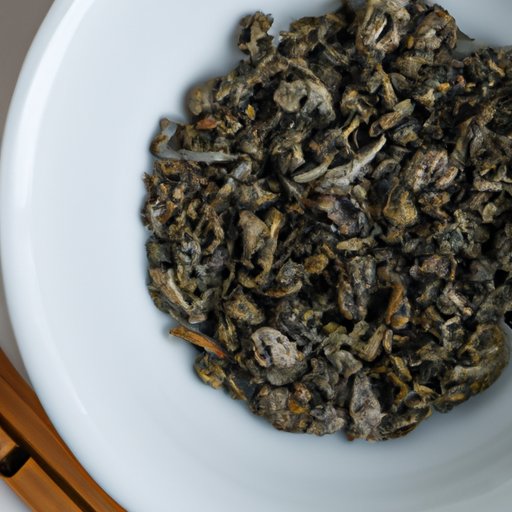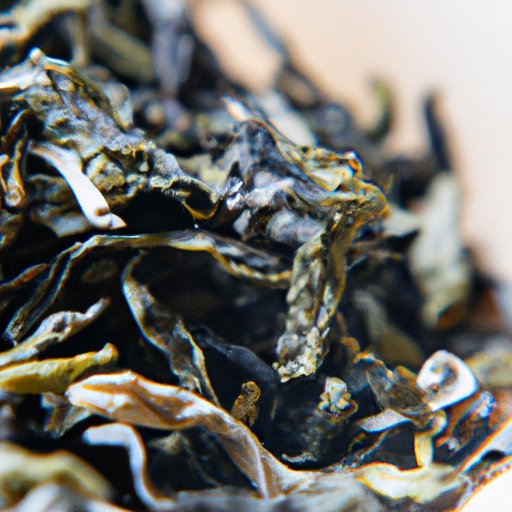Introduction
Welcome to the world of oolong tea! If you are a tea lover or simply curious about the world of tea, you may have heard of oolong tea before. It is a unique and fascinating type of tea that offers a multitude of health benefits and a wide range of flavors and aromas. In this article, we aim to provide a complete guide to oolong tea, from its rich cultural significance to its growing and processing methods, health benefits, and optimal brewing techniques. So sit back, relax, and let’s dive into the magical world of oolong tea!
Experience the Ancient Tradition of Oolong Tea: Everything You Need to Know
Before we explore the intricacies of oolong tea, let us first understand what it is. Oolong tea is a type of tea that falls between green tea and black tea in terms of processing and oxidation. It originated in China’s Fujian province, where it has been a part of Chinese culture and tradition for hundreds of years. The name “oolong” translates to “black dragon” in Chinese, which refers to the dark, twisted appearance of the tea leaves.
Oolong tea is appreciated for its unique flavors and aromas that range from floral, fruity, and nutty to woody, smoky, and earthy. It is also prized for its numerous health benefits, which we will explore in more detail later in the article. Different types of oolong tea vary in oxidation levels, processing methods, and growing regions, leading to a wide range of flavors and colors.
From Field to Cup: The Journey of Oolong Tea
The journey of oolong tea begins with the tea plant, Camellia sinensis. Oolong tea is mostly grown in China and Taiwan, with some production in other parts of Asia. Climate and altitude are crucial factors in determining the quality and flavor of the tea. Generally, high altitude and cooler temperatures result in better quality tea leaves.
The harvesting process of oolong tea depends on the variety and type of tea. Most oolong tea is harvested by hand, which allows for the selection of mature leaves and buds. The timing of the harvest is also essential, as the leaves must not be too young or too old. After harvesting, the tea leaves undergo a series of processing steps that make oolong tea unique.
The first step in processing oolong tea is to wither the tea leaves under the sun or in a shaded area. This step reduces moisture in the leaves and prepares them for the next step, shaping. In shaping, the tea leaves are twisted and rolled by hand or machine to release their juices and initiate oxidation. The degree of oxidation varies depending on the type of oolong tea, but typically varies between 10% and 70%.
Oxidation is the process that results in the characteristic flavor and aroma of oolong tea. Higher oxidation levels result in darker, stronger teas, while lower oxidation levels produce more delicate and floral teas. After oxidation, the tea leaves undergo fixation to stop the oxidation process. This step may involve heating the leaves in a pan, steaming them, or baking them. Finally, the tea leaves are dried and sorted before being packaged and sold.
Unlocking the Health Benefits of Oolong Tea: A Comprehensive Guide
Oolong tea is not only a delicious drink, but it also provides numerous health benefits. The unique chemical composition of oolong tea makes it a rich source of antioxidants, vitamins, and minerals. The following are some of the health benefits associated with drinking oolong tea:
- Weight management: Oolong tea may help boost metabolism and aid in weight loss.
- Reduced risk of heart disease: Regular consumption of oolong tea may help lower blood pressure and cholesterol levels, reducing the risk of heart disease.
- Improved bone health: Oolong tea is a source of calcium, magnesium, and other minerals that support bone health.
- Improved mental alertness: Oolong tea contains caffeine, which can help improve mental alertness and focus.
- Reduced risk of cancer: The antioxidants in oolong tea may help prevent the growth of cancer cells.
The health benefits of oolong tea are due to its unique chemical composition, which includes catechins, theanine, caffeine, and polyphenols. These compounds help fight inflammation, boost metabolism, and improve immune function. Several scientific studies have also supported the health benefits of oolong tea.
However, it is essential to note that excessive consumption of oolong tea can lead to side effects such as caffeine sensitivity, insomnia, and stomach upset. People with certain health conditions or on medication should consult their doctor before consuming oolong tea.
Discovering the Many Flavors of Oolong Tea: A Tasting Journey
One of the most exciting aspects of oolong tea is its wide range of flavors and aromas. Different varieties of oolong tea can vary significantly in taste, from floral and delicate to smoky and earthy. The following are some of the popular oolong tea varieties and their flavor profiles:
- Tie Guan Yin: A fragrant and floral tea with a sweet aftertaste
- Da Hong Pao: A smoky and robust tea with hints of honey and fruit
- Jin Xuan: A creamy and buttery tea with a milky aroma
- Feng Huang Dan Cong: A complex and fruity tea with notes of peach, apricot, and almond
The flavor of oolong tea is influenced by factors such as the growing region, altitude, soil, and processing method. Those looking to explore the world of oolong tea should try different varieties and brewing methods to discover their favorites. Oolong tea can be enjoyed on its own or paired with food, such as cheese, chocolate, or seafood.
Brewing the Perfect Cup of Oolong Tea: Tips and Tricks
Like all teas, oolong tea requires specific brewing techniques to bring out its optimal flavor and aroma. While there are various brewing methods, the following are some tips and tricks for brewing the perfect cup of oolong tea:
- Choose quality tea leaves: The quality and freshness of tea leaves can significantly impact the flavor of the tea.
- Use the right amount of tea: The recommended ratio is 1 teaspoon of tea leaves per 8 ounces of water.
- Control water temperature: Oolong tea requires water temperatures between 180°F and 200°F, depending on the type of tea.
- Shorten or lengthen steeping time: Steeping time for oolong tea varies between 1 and 5 minutes, depending on the desired strength of the tea.
- Enjoy multiple infusions: Some oolong teas can be brewed multiple times, with each infusion producing different flavors and aromas.
Brewing methods for oolong tea vary between traditional methods, such as gong fu style, and western style, such as using a teapot or infuser. Those looking to brew oolong tea should experiment with different methods to find the one that suits their preferences the most.

The Role of Oolong Tea in Chinese Culture and History
Oolong tea is more than just a beverage; it holds a significant cultural and historical significance in China. Oolong tea has been a part of Chinese culture for hundreds of years and has played an essential role in Chinese tea ceremonies and traditions.
Tea ceremonies are an integral part of Chinese culture, with oolong tea playing a significant role in both casual and formal settings. Oolong tea represents respect, gratitude, and hospitality in Chinese culture and is often served at weddings, birthdays, and other celebratory events.
Oolong tea has also been the subject of numerous artistic and poetic portrayals throughout Chinese history. Many famous Chinese poems and paintings have depicted oolong tea and its beauty, with artists and writers admiring its unique flavors and aromas.
Oolong Tea vs. Other Teas: What Sets It Apart?
While oolong tea shares some similarities with other types of tea, such as green, black, and white tea, it also has several unique characteristics that set it apart.
Firstly, oolong tea falls between green and black tea in terms of oxidation. This results in a unique combination of flavors and aromas that are different from any other type of tea.
Secondly, oolong tea is processed differently than other teas. The processing steps involve withering, shaping, oxidation, fixation, and drying, resulting in a tea with a unique texture and appearance.
Finally, oolong tea provides unique health benefits due to its rich chemical composition. While other teas also provide health benefits, oolong tea’s combination of antioxidants, vitamins, and minerals make it a powerful source of nutrients.
Conclusion
We hope this complete guide to oolong tea has provided you with a thorough understanding of this unique beverage. From its rich cultural significance to its growing and harvesting process, health benefits, and optimal brewing techniques, oolong tea offers a world of flavors and aromas to be explored. We encourage you to try different varieties and brewing methods to find your favorite oolong tea. With its numerous health benefits and rich history, oolong tea truly is a magical beverage.
If you are looking to buy or try oolong tea, we recommend visiting your local tea shop or online retailers that specialize in tea. With its wide range of flavors and aromas, oolong tea offers something for every tea lover.
So, what are you waiting for? Brew yourself a cup of oolong tea, sit back, and enjoy the beauty and benefits of this exquisite beverage.
